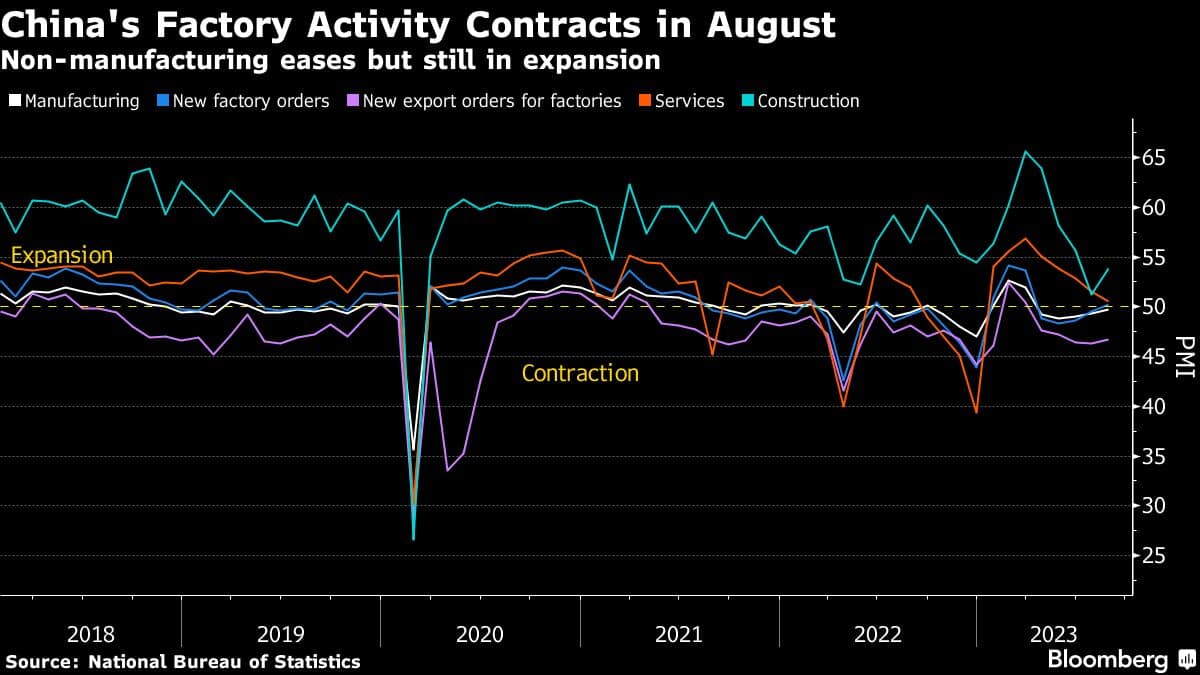



China’s manufacturing activity contracted for the fifth consecutive month in August, as calls grow for President Xi Jinping’s government to take concrete steps to boost the world’s second-largest economy.
The official manufacturing purchasing managers’ index rose slightly to 49.7 last month, according to the National Bureau of Statistics, in contraction but still an improvement over the 49.3 reading in July. That was better than the median estimate of 49.2 in a Bloomberg survey of economists.
The non-manufacturing gauge — which includes activity in the construction and services sectors — fell to 51, below the estimate of 51.2. The 50 mark separates expansion from contraction compared to the prior month.

China’s economic recovery has weakened after a burst of activity in the first quarter of this year, with a prolonged property slump weighing on sentiment. The nation’s manufacturers have been struggling for months because of a slump in global demand and subdued domestic spending. Deflation has put pressure on industrial profits as well, with data on Sunday showing a 6.7% contraction in July.
China’s onshore stocks erased a loss of 0.2% to trade slightly higher after the data, while a gauge of Chinese stocks listed in Hong Kong gained as much as 1.2%. The offshore yuan and the Australian dollar extended gains. China’s 10-year government bond yield was steady at 2.59%.
While factory activity remained in contraction from the prior month, the better-than-expected reading suggested that Chinese factories are rebuilding their inventory stock, according to Zhaopeng Xing, senior strategist at Australia & New Zealand Banking Group Ltd., noting that sub-indexes for production and new orders expanded.
The non-manufacturing PMI, though, showed a “mixed picture,” he said. “Construction activities became better and service activities slid,” he said. “We expect the weakness will continue with the end of the summer holiday.”
“The survey results show insufficient market demand remains a major problem faced by enterprises currently. The foundation for manufacturing recovery still needs to be consolidated further,” NBS analyst Zhao Qinghe said in a separate statement accompanying the data release.
The services sector has held up better than other parts of the economy, providing a bright spot amid the gloom. Even so, a gauge measuring services activity eased to 50.5 in August — still in expansion but the weakest reading since December.
Spending on goods, meanwhile, has lost momentum, with retail sales growth slowed in July to 2.5%, missing expectations.
Key Details From the Data:A manufacturing sub-index measuring new orders expanded for the first time since March, reaching 50.2
A manufacturing sub-gauge measuring employment weakened to 48 in August from the prior month
New export orders improved slightly to 46.7 but remained in contraction for a fifth straight month
A sub-gauge measuring suppliers’ delivery times increased to 51.6 from 50.5
Policymakers have resisted rolling out massive stimulus to support the economy, wary of driving up debt and exacerbating financial risks. A gloomy income and job outlook has also kept businesses and households reluctant to borrow, making it hard for easing measures to have a material impact on economic activity.
The People’s Bank of China has cut policy interest rates twice this year, though, while the nation’s biggest lenders are expected to trim rates on existing mortgages in a concrete step to support growth. Authorities have also pledged in recent days to speed up fiscal spending.
Discover the latest Business News, Sensex, and Nifty updates. Obtain Personal Finance insights, tax queries, and expert opinions on Moneycontrol or download the Moneycontrol App to stay updated!
Find the best of Al News in one place, specially curated for you every weekend.
Stay on top of the latest tech trends and biggest startup news.